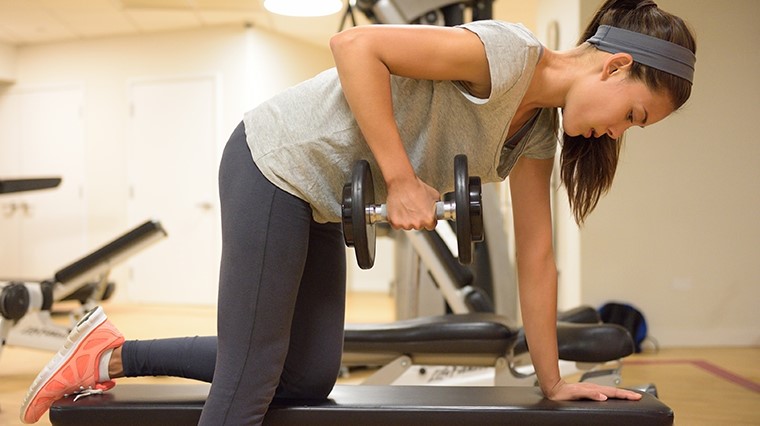"Brace Your Core" - What Does That Even Mean?

Whether you’re feeling the burn in squats or finding your posture in Pilates, no doubt you’ve heard the term brace your core… but what does that even mean, and how the heck do you do it?
It’s time to shake off the misconceptions – it’s not sucking in your gut, blowing your tummy up like a balloon or holding your breath until you turn blue like a smurf.
What is your ‘core’ anyway?
Your core is not an isolated muscle or muscle group – in fact, it consists of your abdominal or ab muscles (deep beneath your 'six-pack' zone), hip, pelvis and back muscles.
In Pilates, your core is referred to as the T-Zone. Visualise a ‘T’ on your body, with the vertical line of the T drawn between the pubic bone and belly button, representing your pelvic floor muscles.
The horizontal ‘hat’ of the T runs between your hip bones and includes any muscle that wraps your midsection horizontally, like a corset around your abdomen and spine (transverse abdominis muscles, or TVA for short).
Why brace your core?

Bracing your core is essential for exercises that require stability, particularly weight training, CrossFit and Pilates where these muscles must work in harmony.
The tension or tightening of the pelvic floor, abdominal muscles and back muscles naturally creates a stiffer support of the spine to protect the back during lifting, maintain correct posture and balance.
Although it’s second-nature to brace your core when standing up on a bumpy bus ride or when you're about to get pounced on by a super enthusiastic Labrador, unless well-practiced, ‘switching on’ your abs or T-Zone for exercise does take conscious effort.
How do you brace your core?

Rather than sucking in your gut, focus on the deeper, inner muscles. Identifying the right muscles can be difficult, but there’s a trick to it. Try these cues to test out what works for you.
Step 1: Lift your pelvic floor (the vertical line of the T-Zone). Imagine you’re:
- Pausing the flow of urine midstream by gently lifting and squeezing your pelvic floor muscles up towards your belly button.
- Zipping up an imaginary line from your pubic bone to belly button and follow the zip upwards as you tense the muscles.
Step 2: Activate your TVA (the horizontal line of the T-Zone). Imagine you’re:
- Squeezing the imaginary line between your hips gently inwards to do up the button on tight jeans.
- About to get punched in the guts. Sucks right? But that reaction of tensing and contracting your abdominals engages the correct muscles.
Breathe naturally, holding the contraction for 3-5 seconds, then allow your muscles to relax a few seconds before the next rep.
The ‘hip’ test
Hopefully you had an ‘aha!’ moment when testing out the cues above and have felt the deep, inner shift of your pelvic floor muscles as they lift.
But as a test, position your fingertips at the inside of your hip bones and gently press in. When you’re relaxed, this area will feel soft and spongy, but when your core is activated, it’ll feel firmer.
Overtime as you master bracing your core this difference will become more obvious.
Sure you’re not just sucking in your gut?

Don't worry, we have a tip for that too. To identify the difference between sucking in your gut and bracing your core, it helps to stand side on in front of a mirror with just a sports bra or topless to observe your body.
When you’re bracing your core, only your lower abdominals should be in play – you’ll notice improved posture as well as a slight flattening and tightening of the area, but the change is subtle in comparison to the 'suck'.
When sucking in your gut you’ll actually lose stability and breathing will be more difficult - there will be a clear shift as your rib cage becomes more predominant and your stomach hollows inwards.
Should you brace your core for every workout?

Sorry to burst your bubble but no, now that you have the knack of it, it doesn’t mean you should brace your core non-stop or for every workout.
Core training can improve your running form, but consciously tensing your core while running can impede the elasticity of your muscles and make you feel stiff like a robot - so it's best to let your core do its thing instinctively.
Feel free to practice core bracing when standing in line at the cupcake store or during a Netflix binge, but be aware like any muscle your abdominals and pelvic floor need to relax and recover to prevent weakening and becoming overworked.
Workout Safely
For high intensity workouts, please consult your personal trainer on correct core bracing and breathing technique for the specific activity.
With that in mind, it’s time to hit the Pilates mat, do some light strength training and put those abs to work!
